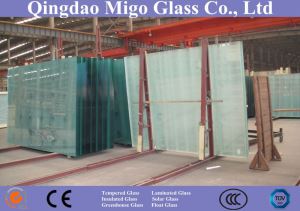Hey there! I'm a supplier of Low - E Glass, and I've been in this industry for quite some time. Over the years, I've seen firsthand the amazing things that happen when you combine Low - E Glass with other glass types. In this blog, I'm gonna share with you the benefits of this combination.
1. Enhanced Energy Efficiency
One of the most significant benefits of combining Low - E Glass with other glass types is the boost in energy efficiency. Low - E Glass, as the name suggests, has a low emissivity coating that helps to reflect heat. When you pair it with, say, regular float glass, you create a more effective barrier against heat transfer.
For instance, in the winter, the Low - E coating reflects the heat back into the building, keeping the interior warm. And in the summer, it reflects the sun's heat away, reducing the need for air conditioning. This energy - saving property can lead to substantial cost savings on energy bills. You can check out our Energy Efficient Low - E Glass Panel for more information on how it works to save energy.
2. Improved Insulation
Combining Low - E Glass with other glass types can significantly improve insulation. When used in double - or triple - glazed windows, Low - E Glass works in tandem with the other glass panes and the air or gas space between them. The Low - E coating helps to reduce the transfer of heat through the glass, while the multiple panes and the insulating gas (like argon) add an extra layer of insulation.
This means that your building will be better protected from outside temperature fluctuations. You'll notice a more stable indoor temperature, which is not only more comfortable but also helps to reduce wear and tear on your heating and cooling systems. Our Low - E Insulated Glass Curtain Wall is a great example of how this combination can provide excellent insulation for commercial buildings.
3. Better UV Protection
Another advantage is better protection against ultraviolet (UV) rays. Low - E Glass can block a large portion of the UV radiation that can cause fading and damage to furniture, carpets, and artwork inside a building. When combined with other glass types, this protection can be further enhanced.
For example, some specialty glass types have their own UV - blocking properties, and when paired with Low - E Glass, they can create a more comprehensive UV - protection system. This is especially important for buildings with large windows or glass facades, where the sun's rays can have a more significant impact.
4. Enhanced Aesthetics
Combining Low - E Glass with other glass types can also enhance the aesthetics of a building. Different glass types come in various colors, textures, and finishes. By mixing and matching, architects and designers can create unique and visually appealing facades.
For instance, you can combine clear Low - E Glass with tinted or patterned glass to add depth and character to a building's exterior. This not only makes the building stand out but also allows for more creative design possibilities. Whether it's a modern skyscraper or a residential home, the right combination of glass types can transform the look of a building.
5. Increased Safety and Security
When it comes to safety and security, combining Low - E Glass with other glass types can be beneficial. Some glass types, like laminated glass, are designed to be more shatter - resistant. When paired with Low - E Glass, you can create windows and doors that are not only energy - efficient but also more secure.
In the event of an impact, laminated glass holds together even if it breaks, reducing the risk of injury from flying glass shards. This added safety feature can give building owners and occupants peace of mind. And with the energy - saving benefits of Low - E Glass, you're getting a win - win situation.
6. Customization Options
Combining Low - E Glass with other glass types offers a wide range of customization options. Depending on the specific needs of a project, you can choose different combinations to achieve the desired performance and appearance.
For example, if a building is located in a very hot climate, you might want to combine Low - E Glass with a high - performance solar - control glass to maximize heat rejection. On the other hand, in a cold climate, you could pair it with a thick, insulating glass for better thermal performance. This flexibility allows for tailored solutions for different building projects.
7. Sound Insulation
In addition to the other benefits, the combination of Low - E Glass with other glass types can also improve sound insulation. Multiple panes of glass, along with the air or gas space between them, can help to reduce the transmission of noise from the outside.
This is particularly important for buildings located in noisy areas, such as near busy roads or airports. By choosing the right combination of glass types, you can create a more peaceful and quiet indoor environment.


Why Choose Our Low - E Glass for Combinations?
As a Low - E Glass supplier, I can tell you that our products are top - notch. We use the latest technology and high - quality materials to produce Low - E Glass that performs exceptionally well. Our Low - E Glass is available in different types, including Single Glazed Low - E Glass, which can be a great option for certain applications.
We also offer a wide range of customization options, so you can easily combine our Low - E Glass with other glass types to meet your specific project requirements. Our team of experts is always ready to provide you with advice and support to ensure that you get the best combination for your building.
Let's Talk!
If you're interested in learning more about how combining Low - E Glass with other glass types can benefit your project, I'd love to hear from you. Whether you're an architect, a builder, or a building owner, we can work together to find the perfect glass solution for your needs. Reach out to us, and let's start a conversation about your project. We're here to help you make the most of the benefits that this combination has to offer.
References
- "Energy - Efficient Windows: A Guide for Homeowners", U.S. Department of Energy
- "Glass in Architecture: Design and Technology", John W. Miles
- Industry reports from the glass manufacturing and construction sectors.

